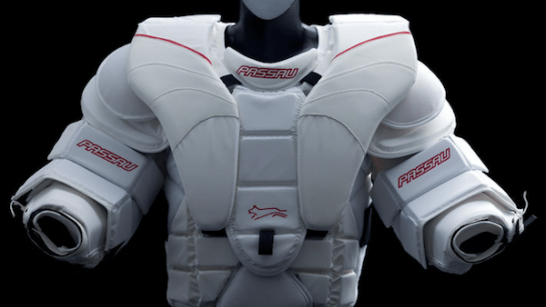Shrinking equipment no easy task for goalie cop Whitmore

Original Source: MICHAEL TRAIKOS, POSTMEDIA NETWORK
Posted on: Mar 13, 2016
TORONTO — The NHL’s goalie cop is working a different case these days.
Clutching a binder in one hand and a measuring tool he picked up for $9.99 at Princess Auto in the other, Kay Whitmore walked unannounced into the visiting dressing room at Air Canada Centre recently and spotted Buffalo Sabres goaltender Robin Lehner undressing in his stall.
“Uh oh, here comes my nemesis,” Lehner said. Whitmore laughed.
Actually, nothing could be farther from the truth.
The former NHL goaltender-turned-equipment inspector might be on a quixotic crusade to shrink the sumo-sized masked men who have spent their careers bulking up and bending the rules, but he’s not here out to bust Lehner.
Well, at least not today.
Instead, he has come to take measurements so that goalie manufacturers can specifically tailor equipment that is fitted to Lehner’s body like a made-to-order tuxedo, not an off-the-rack polyester suit. It is the latest — and maybe last — attempt at making goaltenders look like their actual size in net.
Whether it helps increase scoring is undecided at this time. Who knows, it could make goaltenders more mobile and athletic. But, at the very least, it levels the playing field and forces the NHL to look elsewhere for answers.
“I love that. I love that idea,” Lehner said. “It’s just not consistent through the league. A lot of goalies have way-too-big equipment on. They can fit four sets of arms in one sleeve of the chest protector. I know guys in this league who wear player pants underneath their goalie pants. That’s how big their pants are.
“You see guys look like absolute monsters on the ice. It’s nuts. You can have guys weigh 175 and they look like a 300-pound sumo wrestler out there.”
Lehner, who wears the biggest pants he can find, also looks like one of those so-called monsters. But he comes about his size honestly. Listed at 6-foot-4 and 223 pounds, Lehner said he is really closer to 250 pounds, has a 42-inch waist and ankles that Whitmore jokes are as big as some goaltender’s thighs.
“I am a big guy and I know that I am a big guy. I have very wide shoulders and big legs,” Lehner said. “If you look here (points at his waist), I don’t have much room in my pants. I’m an XL. But everyone in the league is in XL.”
This is the challenge presented to Whitmore, who will make a presentation at next week’s GM meetings in Boca Raton, Fla. The NHL is not a one-size-fits-all league.
Some, like Ryan Miller of the Vancouver Canucks, are tall and skinny. Others, like Los Angeles Kings' Jonathan Quick, are shorter and stockier. There are several variations in between yet, when suited up, most look the same.
Whitmore’s goal is to make the equipment more representative of a player’s individual body type. He wants chest protectors that cling to the arms and shoulder rather than hang like drapes and for the pants to be more like what Justin Bieber, not MC Hammer, would wear.
Ultimately, he wants goalies to look different from one another. And, for a change, goalies want the same thing.
“I think we should all be on the same playing field, doing the same thing, and let the talent win out,” Cory Schneider, who is on the NHL-NHLPA competition committee, said during All-Star Weekend in January. “If you're talented, can move around the net and stop pucks, those are the guys that should be in the league.”
At the all-star game in Nashville, Whitmore presented prototypes of the new equipment to Schneider, the New Jersey Devils backstopper, Braden Holtby of the Washington Capitals, and Tampa Bay Lightning's Ben Bishop. They hated it. Not because it was too small, but because it wasn’t small enough.
“The PA and I weren’t super happy,” Whitmore said. “It wasn’t what we were looking for and the goalies agreed. Cory Schneider said it best: ‘It’s hard to explain what we’re asking them to do, but when we see it we’ll know.’”
The problem here is two-fold: in order to have equipment that is contoured to the natural shapes of the body, you have to physically measure every single goaltender to see what sizes they should be wearing. Then, you have to have to convince each equipment manufacturers — Bauer, CCM-Reebok, Brian’s and Vaughan — to design padding that simply protects the goalie rather than gives them an edge in eliminating the five-hole.
“It’s not embedded in their mindset to make stuff just to protect like they do for players,” Whitmore explained. “It’s always, ‘How can I fill space?’ It’s trying to get them to come around and think differently for once.”
It’s not as easy as analyst and former NHL goalie Corey Hirsch made it look in a recent video for Sportsnet, where he used a computer animation to visually shrink the equipment.
CLICK HERE to keep reading
